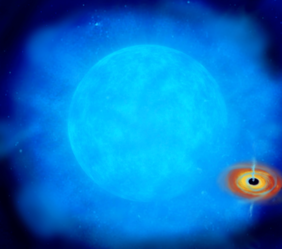Cygnus X-1 Rewritten: Iconic Black Hole System Revealed as Lighter, Yet Richer in Heavy Elements Than Expected
Heidelberg, Germany, May 26, 2025 - An international team of astronomers lead by Varsha Ramachandran from the Center for Astronomy of Heidelberg University has unveiled surprising new insights into Cygnus X-1, the Milky Way’s first confirmed black hole system. The findings dramatically reshapes our understanding of this benchmark cosmic duo, revealing that both the black hole and its massive companion star are significantly lighter than previously thought - and that the star is unexpectedly rich in heavy elements. The study "Comprehensive UV and Optical Spectral Analysis of Cygnus X-1: Stellar and Wind Parameters, Abundances, and Evolutionary Implications." was now published in the science journal Astronomy & Astrophysics.
Cygnus X-1 - discovered in the 1960s - is one of the strongest X-ray sources in the sky and one of the first widely accepted black hole candidates. It is a binary star system located about 7000 light-years from Earth in the constellation Cygnus and consists of a black hole and a massive blue supergiant companion star.
Using sophisticated stellar atmosphere modeling and decades of high-resolution data from instruments like the Hubble Space Telescope, a team of astrophysicists now conducted the first combined ultraviolet and optical spectral analysis of the Cygnus X-1 system. Their findings suggest that the black hole weighs around 14 solar masses, while the companion star, HD 226868, is about 29 solar masses - both notably lower than the prior estimates of around 21 and 40 times the mass of the sun, respectively.
“Previous studies often relied on simplified assumptions,” explained Dr. Varsha Ramachandran, lead author from the Astronomisches Rechen-Institut, which is part of the Center for Astronomy of Heidelberg University “Our models account for the star’s complex wind dynamics and the influence of X-ray radiation from the black hole’s accretion disk, providing a much clearer picture.”
Perhaps most startling is the chemical composition of the star. While surface enhancements of helium and nitrogen are expected in evolved massive stars, the researchers found exceptionally high levels of iron, silicon, and magnesium - 30% to 80% above solar levels.
“This super-solar metal content is quite puzzling,” said Elisa Schoesser, PhD student and co-author of the paper. “It’s unlike anything we see in other nearby stars, which usually have fewer heavy elements than the Sun.” The origin of this enrichment remains unclear. One possibility is that the supernova that formed the black hole contaminated the companion star. Alternatively, the system may have formed from an unusually metal-rich gas cloud, though this challenges existing models of galactic chemical evolution. “If these abundances are intrinsic, it will have significant implications for our understanding of stellar evolution and black hole formation in metal-rich environments,” added Dr. Ramachandran.
The study also revises the longstanding view of how the black hole accretes matter. The black hole was previously thought to pull material from the outer layers of the companion star via focused wind or Roche lobe overflow - the process in a binary star system where one star expands beyond its gravitational boundary (the Roche lobe) and transfers mass to its companion, forming an accretion disk. As matter spirals in, it heats up and emits intense X-rays.
However, unlike prior assumptions the data indicate that the black hole is currently capturing only a small fraction of the star’s stellar wind. Nevertheless, the amount is sufficient to power its intense X-ray emission. "The UV spectra don’t support the idea of wind being focused toward the black hole," said Dr. Andreas Sander, co-author and leader of the research group in which Dr. Ramachandran works. “We now understand that even without direct mass transfer, the system can be highly luminous in X-rays.”
The future of Cygnus X-1 could be even more dramatic. The team’s evolutionary simulations show that the star is nearing a critical point: it may soon begin to overflow its Roche lobe, triggering a more intense phase of mass transfer to the black hole. “Once Roche lobe overflow begins, Cygnus X-1 could become an ultra-luminous X-ray source,” said Dr. Ramachandran. “That phase could last thousands of years and significantly affect the black hole’s growth.” Ultimately, after the companion star ends its life and collapses, the system is expected to form a binary black hole pair, which may eventually merge within about 5 billion years.
“This system is a key piece in understanding the life cycles of massive stars in binaries and how they evolve into the powerful mergers we see today in gravitational wave astronomy,” concluded Dr. Sander.
KEY FINDINGS OF THIS STUDY
- Cygnus X-1’s black hole mass revised downward to about 14 solar masses
- The companion star HD 226868 shows 30–80% more iron, silicon, and magnesium than the Sun
- The system does not currently involve direct mass transfer - X-rays are
powered by stellar wind captured by the black hole - The system will evolve into a binary black hole, likely to merge in about 5 billion years, emitting gravitational waves
ORIGINAL SCIENCE PUBLICATION
V. Ramachandran et al., “Comprehensive UV and Optical Spectral Analysis of Cygnus X-1: Stellar and Wind Parameters, Abundances, and Evolutionary Implications.” Astronomy & Astrophysics, DOI: https://doi.org/10.1051/0004-6361/202554184
ADDITIONAL INFORMATION
The Emmy Noether Research Group on Stellar Atmospheres and Mass Loss
Located at the conjunction of observation, theory and numerical astrophysics, the research group focuses around the application and development of stellar atmosphere models to uncover the life and fate of hot stars and their winds. A particular emphasis is research on hot massive stars. With their high luminosity, these stars are major building blocks of galaxies as they dominate their surrounding with their strong stellar winds and their ionizing radiation. As production sites of heavy elements, massive stars also act as engines of the cosmic chemical evolution. By performing quantitative spectroscopy, simulating their winds, and providing predictions for their appearance and feedback, our group aims to uncover more about the enigmatic role of hot and massive stars in our Universe. The research group is hosted at the Astronomisches Rechen-Institut (ARI), which is part of the Center for Astronomy of Heidelberg (ZAH) University. For more information see wwwstaff.ari.uni-heidelberg.de/ansander/
SCIENTIFIC CONTACT
Dr. Varsha Ramachandran
Center for Astronomy of Heidelberg University (ZAH)
Astronomisches Rechen-Institut (ARI)
vramachandran@uni-heidelberg.de
CONTACT FOR MEDIA INQUIRIES
Dr. Guido Thimm
Center for Astronomy of Heidelberg University (ZAH)
thimm@uni-heidelberg.de

